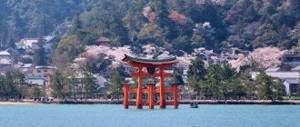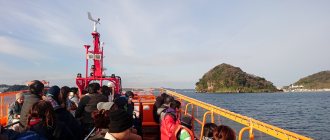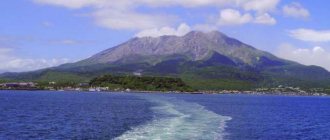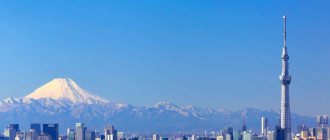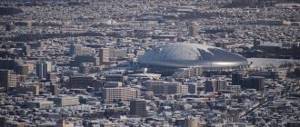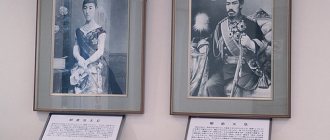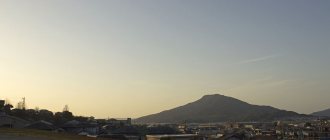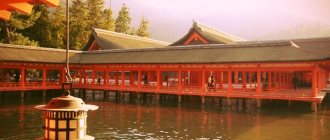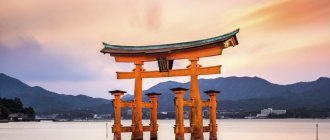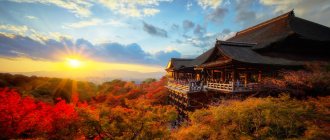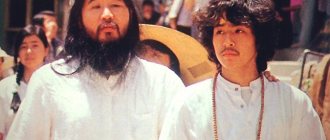Itsukushima Shrine (Japan) - description, history, location. Exact address and website. Tourist reviews, photos and videos.
- New Year tours
around the world - Last minute tours
around the world
1/
10
Itsukushima Shrine
One of the most recognizable symbols of Japan is the red gate of Itsukushima Shrine standing in the water. The temple was built around the 6th century AD. e., acquired its current form in the 12th century, when the ritual torii gates appeared, marking the border between the worlds of the living and the dead. They are regularly renewed; the last one was made from camphor wood and installed in 1875.
They say that one day the sun goddess Amaterasu was offended by her husband (according to another version, her brother), the wind god Susanoo, and hid in a deep cave on the island of Miyajima. Eternal night came and, in order to lure the goddess back, people set up a huge roost - a toria, where they gathered all the surrounding roosters. At the appointed hour, they began to crow, the surprised Amaterasu looked out of the grotto, and remained outside.
Legend about the founding of the sanctuary
The Itsukushima Shinto Shrine is located in the Inland Sea of Japan on the island of the same name, which is better known as Miyajima - Temple Island. This island has been considered sacred since ancient times and was itself revered as a deity.
An ancient legend says that the sun goddess Amaterasu Omikami and her brother Susanoo-no-mikoto met on the High Sky Plain and gave birth to gods and goddesses. Susanoo saw through his sister's necklace, and five male gods were born, Amaterasu saw through Susanoo's sword, and three divine girls were born.
The goddesses began to look for a place where they could settle in silence and unity with nature. And then Saeki no Kuramoto, the ruler of the island, received a sign from above. Guided by the divine raven from the High Sky Plain, he and the goddesses set off to sail around the island. Together they chose a small bay and founded a temple there, and the three goddesses began to be worshiped as guardians of the imperial family, protectors of the Japanese nation and patronesses of sailors. This event is believed to have occurred in 593, when Empress Suiko ascended the throne.
Main buildings
The main objects on the territory of the island temple complex: 1. Itsukushima Shrine / 厳島神社 2. Toyokuni-jinja Temple / 豊国神社(とよくにじんじゃ), with the main shrine Senjyo:kaku / 千畳閣(せんじょうかく). 3. Daishyo-in Temple / 大聖院 4. Omoto Temple / 大元神社(おおもとじんじゃ) 5. Five-tiered pagoda 五重塔 6. Tahoto Pagoda / 多宝塔 (1523) 7. Arched Mo art 反橋 8. Stage of the Noh Theater / 能舞台 (1590)
Itsukushima Shrine is included in the canonical list of the three most famous landscapes of Japan (日本三景), which was compiled back in 1643 by the scholar Hayashi Gaho (林鵞峰). In addition to Itsukushima, this list includes the Amanohashidate Sand “Bridge” in Kyoto Prefecture and the Matsushima Pine Islands in Miyagi Prefecture.
The majestic and imposing Itsukushima Shrine constitutes Japan's national treasure. It is a place of unsurpassed natural beauty of seascapes, mountain landscapes (Misen) and iconic Japanese religious shrines. This is a place where harmony unites the natural world, the divine world and human existence.
As stated in the video below 「その形は心から生まれた美・・・」。 “Itsukushima Shrine is a beauty created from the heart...”.
The video, despite not very good quality (not HD), best conveys the atmosphere of the Itsukushima area:
Thematic dictionary on the topic (for Japanese language learners): 日本三景 (にほんさんけい) - Three famous landscapes of Japan 瀬戸内海 (せとないかい) - Inland Sea of Japan 広島県(ひろしま・けん)- Hiroshima Prefecture (Honshu Island, region Chugoku) 廿日市市 (はつかいち・し)- Hatsukaichi city (Hiroshima Prefecture) 広島湾 (ひろしまわん)- Hiroshima Bay 大鳥居 (おおとりい) - Torii Gate in Itsukushima 柱間 (はしらま) - Distance between gate columns本殿 (ほんでん) - main temple sanctuary 宮島町(みやじま) - Miyajima (広島湾(ひろしまわん) - Hiroshima Bay (瀬戸内海(せとないかい) - Japanese Inland Sea
History of the Itsukushima Shrine Complex
The first documentary evidence of the sanctuary dates back to 811, when Itsukushima was mentioned in the chronicle of Nihon Koki among other famous temples. The sanctuary acquired its splendor in the 12th century, when the military leader Taira no Kiyomori began reconstructing the temple complex. In 1146, this shogun received the post of governor of Aki Province, and the Taira clan began making generous donations to Itsukushima.
In 1168, Taira no Kiyomori laid the foundation for the main temple, the construction of which took several years. The power of the Taira clan grew, and along with it the importance of the sanctuary they built grew. Notable pilgrims, including members of the imperial family, began to visit Itsukushima.
In 1207, and then in 1223, many temple buildings were destroyed by fires, and in 1325 by a strong typhoon. During the civil wars, the fame of the holy site reached unprecedented levels, despite the fact that there was a period when the temple lay in ruins after the Battle of Itsukushima in 1555. Subsequently, Mor Motonari, who won the battle, restored the complex and gave it its former grandeur.
Now the temple fulfills its purpose - religious services, ceremonies and rituals are still held on its territory, ancient manuscripts and objects of art are stored. In 1568, a theater stage was built here, where to this day Japanese noh theater performances are performed, religious music is played, and ritual dances are demonstrated.
Itsukushima seems to be timeless. Despite the fact that the sanctuary is almost entirely built on water and is constantly exposed to the environment - salty sea water, storms, typhoons, visitors can see the same temple that was built 850 years ago, almost in its original form.
Itsukushima Shrine is a unique example of Japanese architecture, one of a kind. Destroyed and reborn from the ashes, revered by many people, having seen many powerful rulers, talented builders, great people in its time, having survived different historical eras, today this temple not only represents a magnificent example of Japanese art, but also symbolizes the spirit of the Japanese people .
Miyajima, sacred island of Japan
The island of Miyajima is considered so sacred by the Japanese that for many centuries people of low birth were not allowed here.
The Japanese's concern for preserving the sacred purity of the island was expressed in the fact that until the beginning of the 20th century. no woman could set foot on Miyajima, so as not to desecrate him. The same desire to protect the sanctity of the island also explains the ban on burying bodies on the island, because, according to the canons of Shintoism, nothing unclean should be done in such a place, which included childbirth and funerals. Therefore, there is no cemetery on the island, and the deceased are transported from Itsukushima.
Also interesting: Devil's Island Alcatraz
Not far from the shore, right from the depths of the waters, a wooden torii gate rises, whose outlines are known all over the world thanks to both examples of traditional art - ancient woodcuts and fans, and the efforts of modern mass media, which have replicated the image of the gate throughout the world as an image of Japan. The torii gate is the personification of the symbolic passage directly to the main shrine of the island. There were some secrets here: the ancient architects, trying to give this passage beauty and elegance, carefully studied the periodicity and height of the tides of the Inland Sea of Japan, which is very shallow in this place. Depending on the fluctuations in water level, the appearance of the corridors and the foundation of the Itsukushima Temple itself and its entire volumetric composition changes, which is the personification of the constancy of the cycle of life.
Another famous building on the island of Miyajima is the Buddhist monastery Daiganji , dedicated to the goddess Benten and considered perhaps the oldest in Japan.
The nearby Five-Storied Pagoda casts a shadow on the Hall of a Thousand Tatami (Senjokaku), built by the personal order of the military ruler Toyotomi Hideyoshi, and today called the Hideyoshi Memorial Shrine.
The monkeys, which have become familiar on the island and which, together with the deer, wander along the embankment and mountain paths of Momijidani (Maple Valley) Park, were brought here only in 1962 for the needs of the local branch of the Japanese Center for the Study of Monkeys in the Wild. Monkeys and deer are fed by visitors to the island who come to pray at the Miyajima Shrine, ride the cable car to the top of Mount Misen, where the life of the Buddhist priest Kobo Daishi (774-835) is connected, and breathe the clean forest air.
At the foot of Mount Misen is Daisho-in , one of the most popular temples of the Shingon Buddhist sect and one of the main temples in western Japan. Here the founder of the sect, Kobo Daishi, first began to practice Buddhism on the island of Miyajima. In the 12th century, Emperor Toba founded his prayer hall here. Daisho-in maintained close ties with the Imperial family until the 19th century. In 2006, the Dalai Lama himself came to the 1200th anniversary of the temple.
At the main gate to Niomon
there are statues of the Gate Guardians.
Also interesting: Hohenzollern, castle in the clouds
In Daisho-in you can find many buildings, statues and other objects of religious worship, often looking very strange to a foreign gaijin.
Of particular interest are the Kannon-do and Maniden halls, the sand mandala created by visiting monks from Tibet and the Henjokutsu cave, where 88 images representing the pilgrimage temples of Shikoku are hung.
Henjokutsu
There are especially many statues of jizo (a popular Japanese deity in the form of a monk, often dressed in a red scarf or knitted hat) on the territory of the monastery.
In the main altar of the Kannon-do hall there is a statue of the goddess Kannon, and in front of it is a mandala made of multi-colored sand, made by Tibetan priests.
Kannon-do
On the terrace of Kannon-do there is a red head with bulging eyes. This is Daruma, a stylized depiction of Bodhidharma, the founder of Zen Buddhism. Such dolls are used in the ritual of making New Year's wishes. First you need to buy a daruma from a Buddhist temple and, making a wish, draw a pupil in one of its eyes. If the wish comes true for the New Year, they draw a pupil in the other eye, if not, they take it to the temple, burn it and buy a new one. Burning the daruma is a message to the Shinto gods-kami, saying that I am looking for alternative ways to realize my desire from the Buddha.
Chokugan-do Hall
, the entrance of which is just opposite the Onarimon gate. Along the steps of the porch there are 20 wooden statues, 10 on each side. Inside there is one large and a thousand small statues of Fudo Myo-o, one of the Five Wisdom Kings.
On the western side of Itsukushima Shrine is the oldest surviving stage for theatrical performances in Japan. When night falls over the Itsukushima Shrine, religious ceremonies begin here, during which gagaku is certainly played - classical Japanese Shinto religious music that originated in the 8th century, during the Nara period. Gagaku music accompanies the bugaku music and dance performance.
Near Mount Misen, which rises nearby, there is another temple on the island - Gunmo Temple (Gunmo-ji-jo). Twice a year - on April 15 and November 15 - a fire ceremony is held here, where ascetic monks walk barefoot through the hot ash - an art that requires great concentration, which the monks achieve by reciting prayers while fixing their gaze on the outlines of Itsukushima Island's temples.
Architecture of Itsukushima Shrine
Fortunately, despite numerous reconstructions and changes of rulers, after 1168 everyone who was involved in the reconstruction of the complex carefully preserved its original appearance. Thanks to this, the external appearance of the temple complex still represents a magnificent example of Japanese architecture of the Heian period (794-1185). The shrine was built in the Shinden style, which includes all the aristocratic buildings of that time, including the imperial palace in Kyoto. And even the main temple, built by Mori Motonari three centuries later, is designed in the same architectural style with the buildings from the time of Taira no Kiyomori.
The temple complex consists of two parts - the outer, which includes 37 buildings, and the inner, which has 19 buildings. Some of the buildings of the complex are built on stilts directly above the water, making it seem as if it is floating on the water surface. The impression is enhanced by Itsukushima’s calling card – the torii gate, which stands right in the water at some distance from the shore.
Torii gate
The most famous part of the complex is the grandiose wooden torii gate, which brought Itsukushima world fame.
Torii are ritual gates that are installed in front of Shinto shrines. Torii are U-shaped and consist of two pillars on each side, on which two crossbars rest. Traditionally they are painted red and never have doors.
Itsukushima's torii amazes with its size - 16 meters high and 12 meters wide, and the length of the crossbar reaches 23 meters. The modern torii were built in 1875 from camphor wood, but chronicles mention a gate that has stood here since the 12th century.
At low tide the seabed is exposed and the gate can be reached on foot. Thousands of pilgrims and tourists from all over the world rush to pass through the sacred gates and leave coins on its pillars. It is believed that this will bring good luck and prosperity, and the wish will certainly come true.
Itsukushima on the map
See more on Putidorogi-nn.ru:
Sights of the Czech Republic: list, description, photos
Europe
25-domed wooden Church of the Intercession: description
Europe
Pannonhalma Abbey: history, description
Europe
Avraamiev Epiphany Monastery: description
Europe
Circuit Gilles Villeneuve: history, features
North America
Azimov Mosque in Kazan: history, description
Europe
Water park KVA-KVA park in Moscow: description, photo
Europe
Aqueduct of Pont du Gard in France: history, description
Europe
Acropolis of Lindos in Greece: history, description, photo
Europe
What do tori symbolize?
A torii is a ritual gate and also symbolizes success and good fortune, so in Japan it is customary for a person who has had good fortune to donate a torii to the temple.
The sacred gate is a kind of transition to the other world, to the world of divine beings - kami. By going through torii, human consciousness is transformed. Whether a person can find himself in the world of kami or not depends only on himself. Before passing through the sacred gates, one must bow, and when passing under them one must prepare to meet the spirits of the dead. If a person, walking along a forest path, comes across a ritual gate, it means that his spirits brought him to it so that he could rethink his life and think about his affairs in it.
Torii are a favorite place for birds. They often like to have “get-togethers” on them. In Japan, they believe that every time birds take off from the gate, they take with them the souls of the departed.
How to get from Hiroshima to Miyajima
From Hiroshima Station, take the Sanyo Line to Miyamaguchi Station, it takes about 20 minutes one way and is included in the price of your pass, which is discussed below. Or you can take the tram directly from Hiroshima City Center to Miyajimaguchi Port. The pier with ferries to the island is just a few steps from the tram station.
The aforementioned train pass, which you can purchase at Hiroshima Station, allows you to travel on the ferry completely free. The ferry will take you to Miyajima in 10 minutes. They depart from Miyajimaguchi from 06:25 to 22:42 and return to Miyajima from 05:45 to 22:14. Most ferries depart every 15 minutes.
You can also take a boat from the Hiroshima Peace Memorial Park. Boat rides operate every 30 minutes, but are not covered by your pass. Boats carry travelers 6-8 times every day.
Temple Island
The UNESCO heritage-listed island is part of a national reserve. Its nature is unique - animals and birds roam here completely freely and are not afraid of people.
The sacred island is good to visit at any time of the year, because in the spring sakura blooms here, in the summer the surrounding forests are filled with the sounds of birds, and in the fall the famous maples turn the island into a huge crimson bonfire.
But Itsukushima is famous not for this, but for its ancient shrine, which attracts adherents of Shintoism and connoisseurs of ancient architecture.
